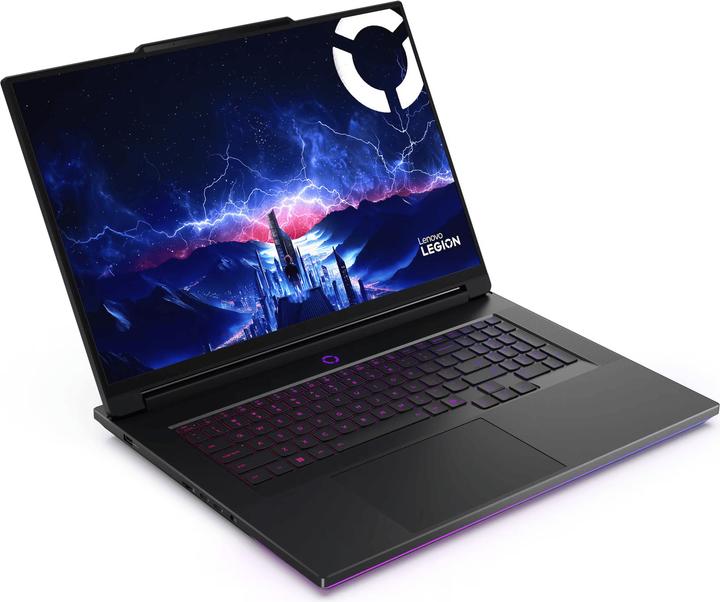

Of heaven and headaches – 3D gaming without glasses on the Legion 9i
The Lenovo Legion 9i isn’t just a ridiculously powerful gaming notebook, but also one with a glasses-free 3D display. Gaming on it sometimes works surprisingly well. But other times, dizziness and headaches take centre stage.
I’m drinking Nuka-Cola, bashing giant cockroaches out of a bunker and nearly losing my balance in Fallout 4 – all in glasses-free 3D. The Lenovo Legion 9i shows depth, layering and pop-out effects directly on the screen. No shutter tech, no VR goggles, no headset. Just my eyes, a lenticular-lens panel and a bit of software magic. Sounds like a breakthrough, right? But it doesn’t always feel like one.
Beyond photos, films and certain 3D-specific software, the 3D feature only works with selected games – 30 titles so far. I put the stereoscopy to the test with Cyberpunk 2077, Fallout 4 and Forza Horizon 5.
Hardware: it’s got it all!
My test unit came fully loaded: Intel Core Ultra 9 275HX, Nvidia Geforce RTX 5090 with 24 GB GDDR7 VRAM, 64 GB DDR5 RAM and a 2 TB PCIe 5.0 SSD. All that is rounded off with an 18-inch, 240-hertz WQUXGA display, HDR400 and glasses-free 3D. The clunky power supply delivers 400 watts, the keyboard has RGB lighting and the rig uses Wi-Fi 7.

Before diving into the 3D feature, here are a few quick observations:
- The keyboard feels good to use even though the keys sit quite close together – my medium-sized man hands just about fit. The key travel is pleasantly short.
- As with every gaming notebook, I’m not at all happy about how loud the fan is. As soon as I start playing, it roars away. With the system at full load, the Legion could serve as a hair dryer.
- The display impresses even without 3D. Colours look natural thanks to IPS technology, but greys, black levels and contrast clearly trail Mini-LED or OLED – anyone walking through dark alleys in Cyberpunk will notice the difference.
Switching to 3D cuts the 3,840 × 2,400 resolution in half. Likewise, the maximum brightness drops from 500 nits by about a quarter.
The 3D effect: made for one person only
The display relies on a lenticular lens that delivers different images depending on the viewing angle. An infrared camera tracks your eye position and synchronises the depth layering in real time. The depth effect is tuned to the position of a single pair of eyes. It gets mixed up as soon as more than one person is sitting in front of it; the second pair of eyes sees double images. Move your head too quickly and the depth plane falls out of sync. To enjoy a solid 3D effect, you’ve got to keep your head still.
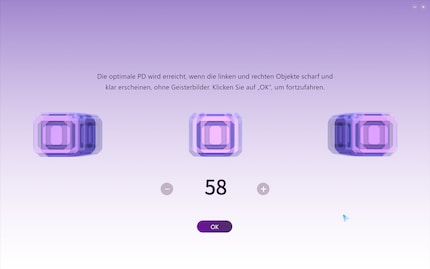
To make it work at all, you need to calibrate the screen. Lenovo shows you a test image with three cubes – one on the left, one in the middle, and one on the right. I adjust the PD (pupil distance) value so that the outer cubes appear sharp without ghosting. The middle cube serves as a reference point and remains unchanged. Once the outer cubes look clear, I click «OK» and the system saves the value.
Calibration is quick, but provides only a baseline. It’s not enough to guarantee perfect 3D settings in every game. As you’ll see in the next section, there are two additional values I had to tweak.
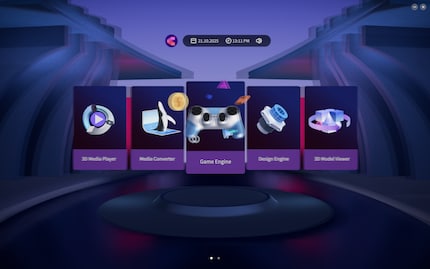
The software that runs everything is called 3D Studio. Alongside the game engine, which provides stereoscopic rendering for supported games, there’s a 3D media player for local videos in side-by-side and top-bottom format. If you want to watch 2D videos in 3D on YouTube, Netflix, Plex and the like, you can use the media converter. It converts the footage in real time as you view it in full-screen mode. To my surprise, it looks about as good as I remember from the 3D cinema.
There’s also the design engine and 3D model viewer for viewing and editing 3D models. Both support formats such as OBJ, FBX and STL, displaying models directly on the 3D screen. The design engine allows for rotation, zoom and simple interaction, but it feels more like a viewer than a full modelling environment.
Supported games: 30 titles, no coincidence
Glasses-free 3D rendering doesn’t work in every case. Lenovo currently lists 30 supported games compatible with the 3D Studio game engine. These aren’t generic DirectX titles but individually tuned games with their own depth profiles.
Why are there so few? Because each game has to be prepared separately. And perhaps because Lenovo only allocates limited resources for it; the game engine doesn’t just render everything double, but generates stereoscopic depth. Each title requires its own profile – depth parameters, interface logic, scene recognition. That’s labour-intensive.
At first glance, the list seems random. But it isn’t. Many of the titles are action-adventures, soulslikes or shooters with clean geometry and a steady camera. Racing games like Forza Horizon 5, on the other hand, benefit from the cockpit view. As for horror and indie, only a few titles are included. Strategy, simulation and UI-heavy games are completely absent.
Gaming in 3D: Forza Horizon 5 is top, Cyberpunk 2077 a flop
After launching the game engine, I can adjust two more values both before and during gameplay. And by «can» I mean «must». If I don’t, the games become more hell than heaven, even with the 3D calibration. The issue? Popout and depth values.
- Popout: controls how the image is layered towards the viewer
- Depth: controls the image’s depth
Sounds simple, but it isn’t. I can’t freely fiddle around with how far something protrudes or how deep the scene appears. There’s usually only one value that works, especially with popout – if it’s off, everything looks misaligned. HUD elements jump about, objects are doubled, and the depth plane loses its connection to the game world.
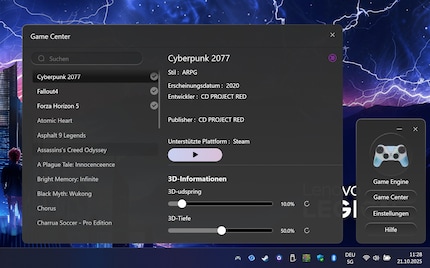
One major criticism is that Lenovo’s software doesn’t save my settings per game. After restarting it, popout always resets to 10 and depth to 50. So I jot down my preferred values on a notepad and re-enter them every time.
Forza Horizon 5 in 3D: a dream
If you think back to the 3D cinema experience with glasses, many people feel odd pressure in their eyes in the first minute, which then fades. With VR headsets, this effect can last up to five minutes. On the Lenovo 3D display it’s somewhere in between – for the first two to four minutes I feel as if my eyes are a bit swollen after crying.
Apart from that, Forza Horizon 5 works – and of the three games tested, it’s the only one that works perfectly. Mind you, only with a popout value of exactly 11.6. Anything above or below creates a double image. The depth seems too low at the preset value of 50, so I raise it to 60. I could even push it higher; only past 80 does it become uncomfortable for the eyes. But the game starts to feel unnatural above 60.
The cockpit view feels three-dimensional, and the environment stays stable. No ghosting, no visual strain. I play for two hours straight without any dizziness or nausea. I feel free and push the pedal to the metal.
Fallout 4 in 3D: game world or Pip-Boy?
Fallout 4 forces me to make a choice – do I optimise the 3D values for the game world or the Pip-Boy, my in-game wearable? Unfortunately, I can’t focus on both. I choose the game world, setting popout to 0.8 and depth to 22. I have to lower the depth that much because higher values look completely over the top, as if a Lenovo developer had gone a bit overboard when creating the profile.
With these settings the world looks normal and the environment discernible, but the text of the Pip-Boy and dialogues has slight ghosting. The doubling is minimal but ever present. But if I put the Pip-Boy in focus instead, the game world looks shifted.
Luckily, I can get used to the mild text doubling, so Fallout 4 is still fun in 3D. The initial excitement I felt with Forza has definitely faded a little, though. Don’t get me wrong, it’s cool – but not necessarily cooler than playing on a large 4K monitor with solid HDR. The laptop’s HDR is modest, especially when 3D is enabled. I don’t notice the lack of a super-high resolution as much, probably because I’ve never experienced 3D in a higher resolution to begin with.
Cyberpunk 2077 in 3D: visual overwhelm
Cyberpunk pushes the system to its limits. The best tuning I could find was popout at 1.4 and depth at 15 – and even then, the image is unstable. Fine details like car antennas or distant objects appear doubled. The depth plane is jumpy, the HUD flickery. I can’t get the 3D environment to work properly.
And the crux: quick camera turns make me nauseous. After 30 minutes of play, my head starts to hurt. The difference between content that’s in focus and ghost images is too stark. I can’t engage properly with the world or the menus. As visual strain increases, immersion drops.
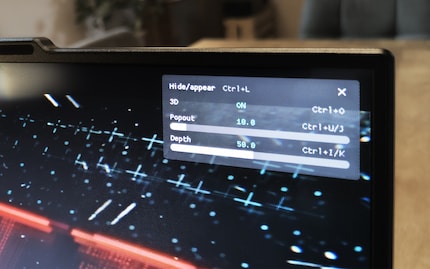
I glance thoughtfully at my 85-inch Mini LED TV. It doesn’t do 3D – but it reaches up to 2,000 nits, shows far more detail in dark scenes and offers perfect black. I’ll take that over the 3D.
Verdict: 3D without glasses is something between wow and why
Glasses-free 3D gaming works. Sometimes surprisingly well. Forza Horizon 5 shows how vivid, stable and enjoyable the experience can be – with popout and depth perfectly aligned. Fallout 4 is a compromise, but it’s playable. Cyberpunk 2077 overwhelms the system.
The technology demands discipline in setting the calibration, adjustment and focus. Those willing to commit will experience moments of genuine depth. Those who just want to jump into play will be disappointed. The software forgets your settings, the display loses brightness, the resolution halves... And still, it’s fascinating to see what’s possible entirely without glasses or a headset.
Is the Lenovo Legion 9 a game-changer with its glasses-free 3D? No. But it’s a stepping stone that shows how much depth a flat panel can offer.
I find my muse in everything. When I don’t, I draw inspiration from daydreaming. After all, if you dream, you don’t sleep through life.
Interesting facts about products, behind-the-scenes looks at manufacturers and deep-dives on interesting people.
Show all

